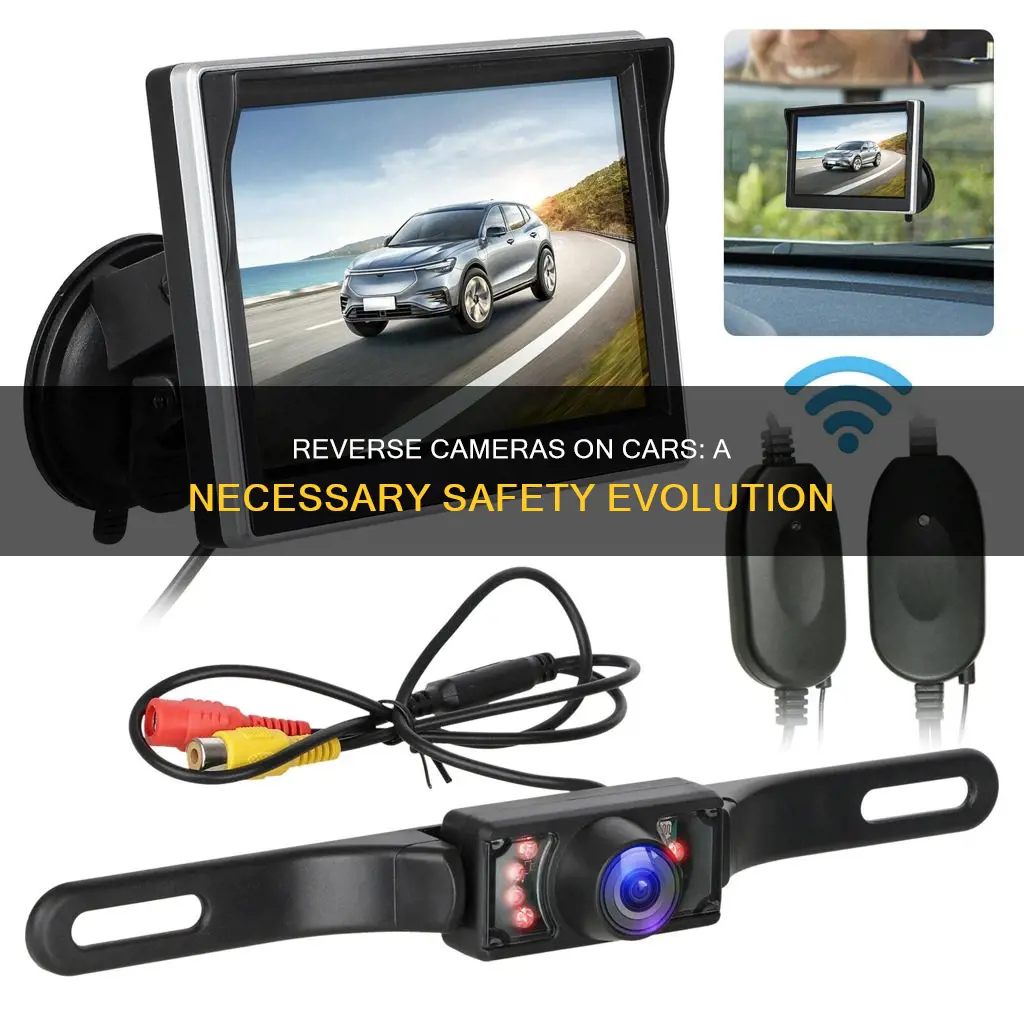
Since 2018, backup cameras have been mandatory on all new vehicles sold in the United States. This legislation was passed to address blind spots and improve rear visibility for drivers, ultimately reducing the number of accidents and fatalities caused by reversing vehicles. Backup cameras provide a clear view of the area behind the car, enhancing safety and helping to prevent backover crashes, which have resulted in numerous deaths and injuries, particularly among children and the elderly.
| Characteristics | Values |
|---|---|
| Country | United States and Canada |
| Vehicle Type | New passenger cars, trucks, buses, and multipurpose passenger vehicles |
| Vehicle Weight | 10,000 pounds or less |
| Purpose | Address blind spots, improve rear visibility, and reduce accidents and fatalities |
| Benefits | Increased safety, enhanced visibility of blind spots, easier maneuvering, and reduced insurance costs |
| Implementation Date | May 2018 |
What You'll Learn
- Reverse cameras reduce the number of fatalities caused by backover crashes, especially in children and the elderly
- They help eliminate blind spots and improve the driver's field of vision
- They can aid in parking, with features like warning tones and on-screen guidelines
- Reverse cameras are now mandatory in the US and Canada for all new vehicles
- They can help drivers save money on auto insurance, as some companies offer safety feature discounts

Reverse cameras reduce the number of fatalities caused by backover crashes, especially in children and the elderly
Reverse cameras are now mandatory on all new cars sold in the US and Canada. This is because they are proven to reduce the number of fatalities caused by backover crashes, which often involve children and the elderly.
Backover crashes are common accidents that occur when a vehicle is exiting a parking spot or driveway. They are usually caused by human error and can be avoided. According to the Insurance Institute of Highway Safety (IIHS), backover crashes result in 292 fatalities and 18,000 injuries annually, with toddlers and children under the age of five being the most common victims. Large vehicles such as SUVs, minivans, and pickup trucks have larger blind spots, which is why they are often involved in backover crashes.
Reverse cameras help to address this issue by providing a clear view of the area behind the vehicle, reducing blind spots, and enhancing the driver's field of vision. This is especially useful for older drivers who may have difficulty turning their heads to check their surroundings. In fact, an IIHS study found that rearview cameras reduced backing crashes by 16% overall and by 40% for drivers aged 70 and older.
In addition to improving safety, reverse cameras can also help with parking and maneuvering in tight spaces. They are also useful when towing a trailer, as they provide a close-up view of the trailer hitch. While reverse cameras are not a replacement for mirrors or physically turning around to look behind the vehicle, they do provide an added layer of protection and can help save lives, especially those of children and the elderly.
Surveillance Cameras: Dynamic DNS for Reliable Remote Access
You may want to see also

They help eliminate blind spots and improve the driver's field of vision
Reverse cameras are now mandatory on all new cars sold in the US and Canada. This legislation was implemented to address blind spots and improve the driver's field of vision, thereby enhancing safety and reducing the risk of accidents.
Blind spots are areas of the road that fall outside a driver's field of vision. They can cover close to half of the space around a vehicle, and their presence can lead to collisions or serious injuries, especially when drivers are pulling out of a parking spot or changing lanes. The area behind the car is a common blind spot, and it can hide anything from a pedestrian to a large vehicle. This creates a significant risk of accidents, particularly when reversing, as drivers may not see obstacles in their path.
Reverse cameras help eliminate these blind spots by providing a clear view of the area behind the vehicle. They offer a horizontal view from one rear corner to the other, pointed at a downward angle to capture any potential obstacles on the ground. This increased field of vision improves safety by allowing drivers to see what is behind their vehicles before reversing.
Additionally, reverse cameras can be combined with high-definition displays and rear automatic braking systems to further enhance visibility and safety. These systems improve the driver's field of vision in low-light conditions or adverse weather and provide an additional layer of protection.
By mandating reverse cameras, legislation aims to reduce the number of accidents, injuries, and fatalities caused by backing up vehicles, especially those involving children and seniors.
Speeding Ticket Arrival: Mobile Camera Edition
You may want to see also

They can aid in parking, with features like warning tones and on-screen guidelines
Reverse parking accidents are a common occurrence, with more than 6,000 people injured yearly by vehicles that are backing up, according to the National Highway Traffic Safety Administration (NHTSA). Of that number, 2,400 are children, and more than 100 of those children die as a result of their injuries.
Reversing cameras are an effective way to aid in parking and prevent such accidents. They can be easily installed in nearly any type of vehicle, regardless of its age. When the car is put in reverse, the camera mounted at the rear of the vehicle is activated and displays a live feed of the area behind the car on a monitor in the cockpit. This helps the driver see any obstacles that may be in their blind spot and avoid colliding with them.
The live feed from the camera is usually flipped horizontally to provide a mirror image, so that the orientation of the display is consistent with the physical mirrors installed in the car. The camera is typically pointed at a downward angle to view potential obstacles on the ground and has a wide-angle lens to provide an uninterrupted view from one rear corner to the other.
Most reversing cameras also have additional features to further aid in parking. These include warning tones that activate when the vehicle gets too close to an object, and on-screen guidelines that help direct the driver into or out of parking spaces. The guidelines can change colour from green to yellow to red as the vehicle gets closer to an obstruction, providing a visual alert to the driver. Some systems also plot the vehicle's projected path as the steering wheel is turned, making parking manoeuvres even easier.
Overall, reversing cameras are a valuable tool for drivers, providing increased visibility and aiding in parking and reversing. They can help reduce the risk of accidents and improve safety for other road users and pedestrians.
Unleashing Creative Control: Understanding Camera Raw's Power
You may want to see also

Reverse cameras are now mandatory in the US and Canada for all new vehicles
In the US, the National Highway Traffic Safety Administration (NHTSA) implemented the requirement for backup cameras on new vehicles, which came into effect on May 1, 2018. This means that all cars manufactured after this date must be equipped with a backup camera and video display. The legislation was first passed by Congress in 2008, but its implementation was delayed until 2014 when the Department of Transportation announced the effective date.
Similarly, in Canada, Transport Canada mandated the installation of rear-view camera systems in new cars and small trucks starting in May 2018. This move brought Canadian standards in line with those in the US, providing Canadians with enhanced safety measures to prevent back-over collisions.
The requirement for backup cameras addresses the issue of blind spots and improves rear visibility for drivers. By providing a clear view of the area behind the vehicle, these cameras significantly reduce the risk of unintentionally striking pedestrians, objects, or other vehicles while reversing. This is particularly important in preventing accidents involving children, the elderly, disabled persons, and other vulnerable individuals.
Backup cameras offer several benefits, including increased safety, enhanced visibility of blind spots, improved awareness of surroundings, and easier maneuvering in tight spaces. Additionally, some insurance companies offer safety feature discounts for vehicles equipped with backup cameras, as they are proven to save lives.
The Focus RS: Reverse Camera Equipped?
You may want to see also

They can help drivers save money on auto insurance, as some companies offer safety feature discounts
Since May 2018, all new cars sold in the US and Canada have been required by law to have reversing cameras. This law was implemented to improve safety by reducing accidents and preventing injuries or fatalities that can occur when reversing. Reversing cameras can help drivers see the area behind their vehicles, which is often a blind spot for traditional rearview mirrors.
While reversing cameras are now standard safety features, insurance companies typically do not offer discounts for cars equipped with them. This is because there is insufficient evidence that reversing cameras significantly reduce accident claims. Insurers are hesitant to offer discounts until they have studied a system's effectiveness and determined if there is an actuarial benefit to their business.
However, some insurance companies do offer safety feature discounts for cars with reversing cameras, as these cameras can technically make your car safer. These discounts can help drivers save money on their auto insurance premiums. For example, SafeDrive Insurance offers a 10% premium discount, SecureAuto Assurance offers a 15% discount, SafetyFirst Insurance offers a 12% discount, and ProtectDrive Insurance offers a 5% discount for vehicles equipped with reversing cameras.
It is important to note that the availability and amount of the discount may vary depending on the insurance company and other factors. Drivers should compare quotes from different insurance providers and review their specific policies to determine if they are eligible for any safety feature discounts.
Caring for Your Camera in Cold Weather: A Quick Guide
You may want to see also
Frequently asked questions
Reverse cameras are mandatory in the US and Canada as they help drivers see into their rear blind spots, which have been described as a "killing zone" due to the accidents they contribute to. This helps to prevent accidents and fatalities, especially in children.
Reverse cameras became mandatory in May 2018 for all new vehicles sold in the US.
Reverse cameras help to prevent accidents and fatalities, especially for children, by giving drivers a clear view of their blind spots. They also help with parking and can aid in hooking up trailers.
Reverse cameras are not a perfect solution as they can become dirty and obscured, and they may malfunction or suffer from signal interference. They should be used in conjunction with mirrors and turning around to look, rather than as a replacement.







